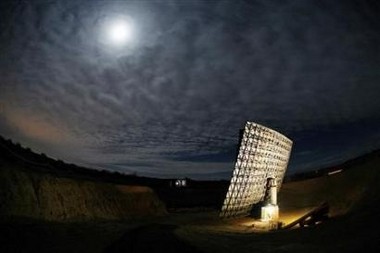Moonstruck flock to Arizona light collector
Updated: 2007-12-06 21:33
Three Points, Arizona - Financial advisor Jaron Ness stands in the cool desert air waiting for the clouds to clear and the moon to rise.
As the conditions come into alignment, he steps into the path of a cool blaze of blue-white light bounced off a wall of highly polished parabolic mirrors five stories high.
 Light from a full moon is reflected off the 'Interstellar Light Collector' onto people in a moveable trailer (small lighted object in center of photo) in the Sonoran desert near Three Points, November 23, 2007. [Agencies] |
"It feels magnetic," he says, turning his hands slowly in the reflected glow of the light from the almost full moon.
The young professional from Colorado is among a growing number of curious people beating a path to this patch of scrub-strewn land out in the Arizona desert to bask in light from the world's first moonbeam collector.
A Tucson-based inventor and businessman Richard Chapin and his wife Monica are behind the giant device, which gathers up and focuses the light of the moon.
The effect of the moon's gravitational pull on the Earth's tides and other natural phenomena has been studied for millennia. Less attention has focused on the sunlight reflected from its surface.
The Chapins built the large, one-of-a-kind contraption that stands in the desert some 15 miles west of Tucson, Arizona, in the belief that moonlight might have applications for medicine, industry and agriculture.
"So much work has focused on the sun. We have just forgotten about this great object that has been here for billions of years, has affected us in all forms of our evolution," said Chapin, who paid for the project with his own money.
"If it could affect plants and animals ... I thought, 'what could the amplification of that light do?"'
Bathing In Moonlight
Neither of the Chapins are scientists. The couple used income from a popular swap meet they own in Tucson to develop what they call their "Interstellar Light Collector," which has so far cost them US$2 million.
It consists of a large frame sunk into a 45-foot-deep (14-meter) crater, on private land in sparse desert, in an area known for its dark skies a few miles from the Kitt Peak National Observatory.
The device is five stories tall and weighs 25 tons, and is covered with 84 mirrored panels set on a hydraulic mount that, the Chapins say, can focus the light of the moon with "the precision of a Swiss watch."
|
|
|
||
|
||
|
|
|
|

